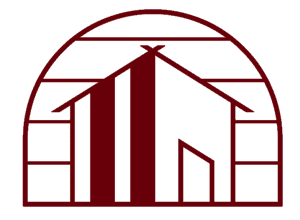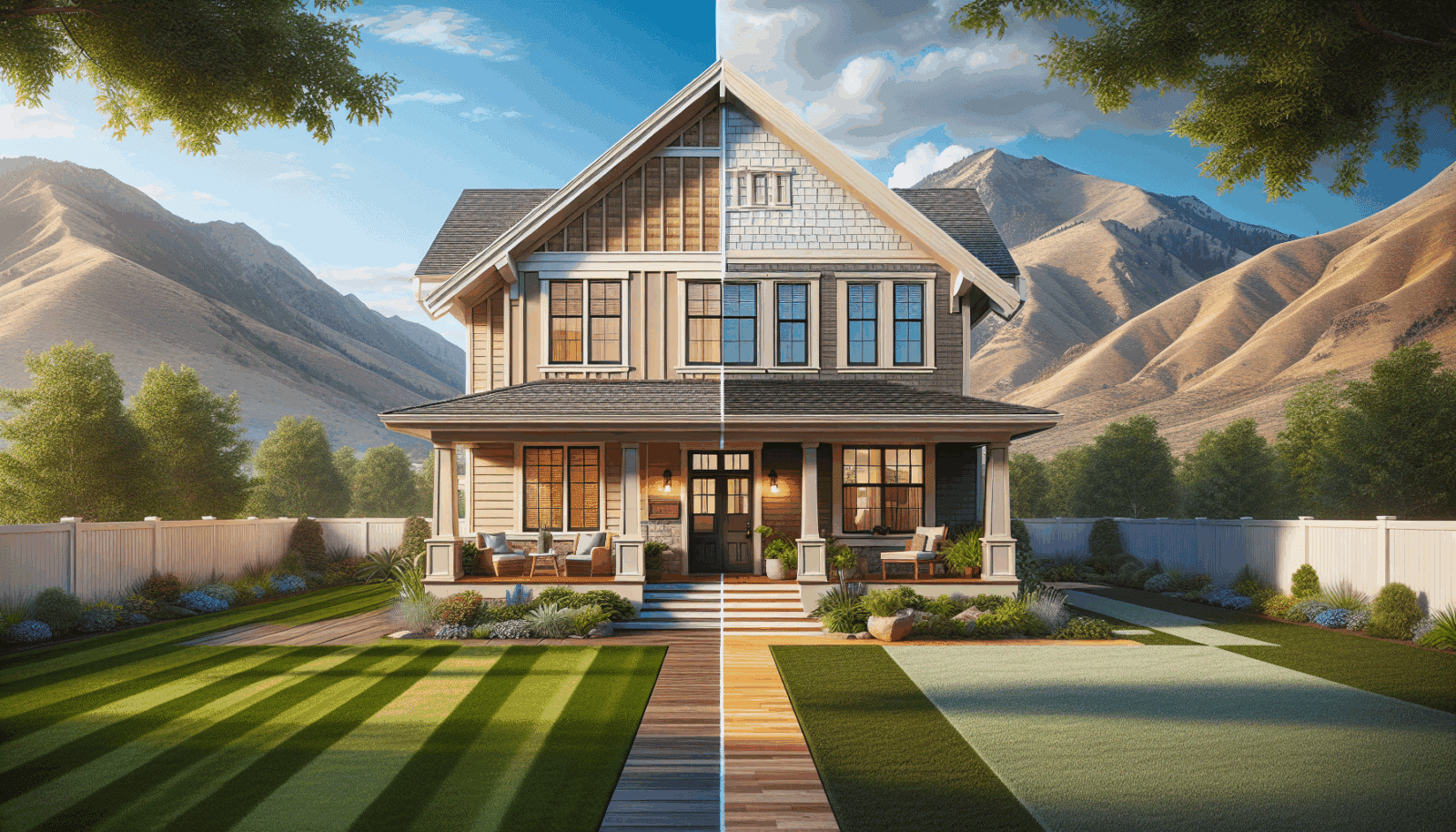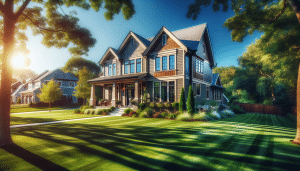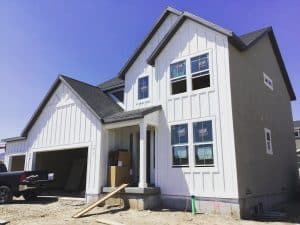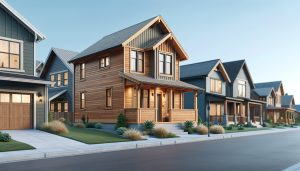Choosing between Hardie Board Siding and Vinyl Siding for your home is not just a matter of taste, it’s also about functionality, longevity, and budget. Here at Utah Siding & Exteriors, we understand the importance of making informed decisions when upgrading your home’s exterior. This article will guide you through the advantages and disadvantages of both siding options, making your choice clearer and more tailored to your specific needs. Whether you’re renovating in Salt Lake County, Davis County, or Utah County, this comparison will be your roadmap to a beautiful, more durable home.
What is Hardie Board Siding?
Hardie Board Siding, also known as Fiber Cement Siding, blends cement, sand, and cellulose fibers into a durable material that withstands the test of time. It is a hallmark of quality and resilience, perfect for homeowners looking for a long-term investment in their property’s exterior. Its versatility enables it to mimic the look of wood, brick, or stone, offering an aesthetic appeal without the extensive maintenance these materials typically require.
One of the top draws of Hardie Board is its exceptional durability. It resists damage from extreme weather conditions, pests, and fire, making it a stellar choice for areas with variable climates or those prone to natural disasters. Its composition also means it won’t rot or warp over time, preserving your home’s pristine appearance for decades.
Understanding Vinyl Siding
Vinyl siding is crafted from PVC (polyvinyl chloride), a type of plastic that offers tremendous versatility and adaptability. It has been a popular choice among homeowners for years, thanks to its balance between quality and cost-effectiveness. Vinyl siding is relatively easy to install, which can translate to lower labor costs and shorter project timelines.
Beyond the practical financial benefits, vinyl siding presents a diverse array of colors and styles, allowing homeowners to achieve their desired look without breaking the bank. It’s also low maintenance, requiring little more than a clean with soapy water occasionally to keep it looking fresh. However, it does have its limitations, especially in terms of durability and environmental impact compared to Hardie Board siding.
Comparing Durability
When it comes to withstanding the elements, Hardie Board siding has a clear advantage. Its composition enables it to resist moisture, rot, and pests more effectively than vinyl, which can sometimes crack in extreme cold or warp in high heat. This resilience means Hardie Board often comes with longer warranties, reflecting its longer expected lifespan.
Vinyl siding, while durable in its own right, doesn’t quite reach the same levels of Hardie Board. It’s more susceptible to damage from high winds and can fade under prolonged exposure to the sun. For homeowners prioritizing longevity and durability, Hardie Board is the stronger contender.
The Cost Difference
Cost is a pivotal factor for many homeowners. Initially, vinyl siding tends to be less expensive than Hardie Board, both in terms of materials and installation. This makes it an attractive option for those with a tighter budget or individuals looking to increase their home’s value without a significant upfront investment.
However, it’s crucial to consider long-term costs. The durability and longer lifespan of Hardie Board siding can mean fewer replacements and repairs down the line, possibly making it more cost-effective in the long run. Moreover, Hardie Board may contribute to higher property value because of its quality and aesthetic versatility.
Style and Aesthetics
Style is subjective, but Hardie Board siding offers a level of versatility that’s hard to match. Available in a wide range of colors and styles, it can mimic more expensive materials like wood, stone, or brick with astonishing accuracy, giving your home a high-end look without the associated maintenance.
Vinyl siding has made significant strides in aesthetics and now offers a broad palette of color and style options. While it may not fully replicate the texture and depth of natural materials as well as Hardie Board, it still provides a clean, attractive finish that can elevate your home’s curb appeal.
Maintenance and Upkeep
The low maintenance nature of vinyl siding is one of its most appealing features. A periodic wash with water, sometimes with a mild detergent, is usually all it takes to keep it looking new. It doesn’t require painting or sealing, making it ideal for homeowners who prefer a “set it and forget it” approach.
In comparison, Hardie Board siding may occasionally need repainting to maintain its vibrant appearance. However, its paint job is known to last much longer than traditional Wood Siding, meaning less frequent touch-ups. Additionally, its resistance to moisture and pests further reduces the need for regular maintenance.
Environmental Impact
Today, more than ever, the environmental impact of our choices is a significant consideration. Hardie Board siding is made of natural and sustainable materials, making it a more eco-friendly option. Its durability also means less frequent replacements, leading to lower consumption of resources over time.
Vinyl siding, being a plastic product, is derived from non-renewable fossil fuels and can release toxic chemicals if burned. While recycling programs for vinyl are becoming more common, its environmental footprint is generally considered larger than that of Hardie Board siding.
Installation Considerations
Installation is a key aspect that can influence your siding choice. Vinyl siding is lightweight and designed for easy, quick installation, which can lead to lower labor costs. Its interlocking panels and pre-drilled holes simplify the process, making it a popular choice for swift renovations.
Hardie Board siding is heavier and requires more specialized labor for installation, potentially increasing the cost and duration of your project. However, this investment in professional installation ensures that your siding is correctly fitted, maximizing its benefits and lifespan.
Deciding Factors for Your Home
- Durability: If you live in an area with harsh weather, Hardie Board’s resistance to wind, rain, and temperature changes makes it a formidable choice.
- Budget Considerations: For immediate cost savings, vinyl siding offers a lower initial investment but consider the potential for higher long-term costs due to replacements.
- Aesthetic Preferences: Hardie Board’s ability to mimic natural materials can give your home a premium look, while vinyl offers a wide variety of colors and styles.
- Maintenance Levels: If you prefer minimal upkeep, vinyl siding’s easy-care nature might be more appealing compared to the painting needs of Hardie Board.
- Environmental Impact: For those prioritizing sustainability, Hardie Board’s natural composition and longer life cycle present a greener choice.
Choosing between Hardie Board and Vinyl Siding for your home exterior is a significant decision, involving factors like durability, cost, style, maintenance, and environmental impact. We hope this comparison has provided valuable insights to help you make an informed choice that enhances your home’s beauty, value, and resilience.
For personalized advice on selecting the right siding option or to start your home improvement project, don’t hesitate to contact us by phone at 801-509-9241 or Request a Free Quote.
